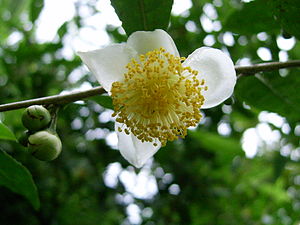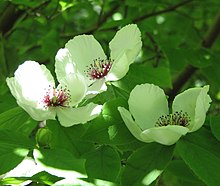Tea bush plants
| Tea bush plants | ||||||||||||
|---|---|---|---|---|---|---|---|---|---|---|---|---|

Blossom of a tea bush ( Camellia sinensis ) |
||||||||||||
| Systematics | ||||||||||||
|
||||||||||||
| Scientific name | ||||||||||||
| Theaceae | ||||||||||||
| Mirb. |
The tea bush plants (Theaceae) are a plant family in the order of the heather-like (Ericales). Economically important species are the tea bush ( Camellia sinensis ), Camellia oleifera as an edible oil supplier and the camellia varieties ( Camellia japonica ) as an ornamental plant . Ingredients in the genus Camellia in particular were examined for their medicinal effects.
description
Vegetative characteristics
They are woody plants: mostly evergreen small (maximum height of 20 meters) trees or bushes . There are unicellular trichomes or they are hairless. The alternate and spiral or two-line arranged on the branches, stalked or sessile leaves have a shiny, leathery and simple leaf blade that is often asymmetrical. The leaf margin is often serrated. The leaves often turn red before they fall off. Stipules are missing.
So-called sclereids are present in many tissues of the tea plant family . H. Cells of various shapes with strongly thickened cell walls; they are often recognizable as tiny dots, for example on the leaf blades.

Generative characteristics
The flowers are usually individually in the leaf axils over two or up to seven bracts or in little-flowered inflorescences . Most hermaphroditic in Laplacea unisexual, flowers are often very striking and radial symmetry . The mostly five, rarely six or rarely more, sepals and five to six, rarely up to ten, petals can grow freely or sometimes somewhat at their base and be arranged in a whorled or (usually) spiral manner. The sepals and petals often merge gradually into one another. There are numerous (more than 40), only fertile , centrifugally arranged stamens . The mostly long stamens are usually free or less often at their base to completely fused and the anthers are short. Most five (three to ten) carpels have become a top permanent ovary grown. There are two to a few ovules per carpel . There are three to five free or only fused styles with cephalic scars or they completely fused to form a style that ends in scar lobes. In the female flowers of Laplacea are staminodes present.
Spherical, woody, loculicidal capsule fruits about 2 cm long are formed on which the sepals are still present and contain some seeds. The seeds, which are often flattened, are over 4 to 20 mm long and have a straight embryo. The seeds of Laplacea are winged.
ingredients
The leaves can accumulate aluminum ions . Examples of organic ingredients are myricetin and ellagic acid .
distribution
Many fossils from the late Cretaceous and the entire Tertiary are assigned to the Theaceae. In the past, this family was an important part of the forests and was widespread in the temperate latitudes of the northern hemisphere .
The tea bush family occurs in the tropics and subtropics . Today the family owns a disjoint area . Main areas of distribution today are the east to south-east Asia and Malesia . The east and southeast of North America are home to about four species.
A good part of the species grows as undergrowth in mountain forests.



Systematics
The surname Theaceae was in 1816 by Charles François Brisseau de Mirbel in Botanical Register; consisting of colored. . . Published, plate 112. Type genus is Thea L. , today a synonym of Camellia L. Synonyms for Theaceae Ker Gawl. are: Camelliaceae DC. , Gordoniaceae Sprengel and Malachodendraceae J.Agardh .
The Theaceae s. l., which earlier consisted of about 30 to 40 genera with more than 600 species, is now part of the families Theaceae s. st. , Sladeniaceae , Pentaphylacaceae (including Ternstroemiaceae) and Tetrameristaceae (including Pellicieraceae) (see also APG III ).
Today the Theaceae only contain the taxa that were previously classified in the subfamily of Theoideae. The family of the Theaceae s. st. today contains about seven to twelve genera with about 195 to 460 species, divided into three tribes . The subdivision into genera and species is difficult and is handled very differently depending on the author, since the relationships and delimitation of the individual genera from one another requires further molecular biological studies.
In the past the family was placed under the order of Theales . It is currently listed under the Ericales .
The family comprises three tribes with the genera:
- Tribe Theeae Szyszylowicz : It contains five genera:
-
Apterosperma Hung T.Chang : It contains only one species:
- Apterosperma oblata Hung T.Chang : This endangered tree species can only be found in forests at altitudes between 800 and 1300 meters in the southern Chinese provinces of Guangdong and Guangxi .
- Camellia ( Camellia L. ): The approximately 120 to 200 species are in northeastern India , Bhutan , Nepal , Myanmar , Thailand , Cambodia , Laos , China (approximately 97 species), southern Korea , Vietnam , Indonesia , southern Japan , and Malaysia common in the Philippines .
- Laplacea Kunth : The eight to nine species are common in the Neotropic .
- Polyspora Sweet : The 40 or so species are common in Eastern Asia and Southeast Asia.
- Pyrenaria flower (including Tutcheria Dunn and Parapyrenaria Hung T.Chang ): The approximately 20 to 25 species are in China (13 species), northeastern India, Indonesia, Japan ( Ryūkyū Islands only), Malaysia, Myanmar, Philippines, Thailand, and Vietnam spread.
-
Apterosperma Hung T.Chang : It contains only one species:
- Tribe Gordonieae DC. : It contains three types:
-
Franklinia W.Bartram ex Marshall : It contains only one species:
- Franklinia alatamaha Marshall : The home is just Georgia .
- Gordonia J.Ellis : The two or so species are common in the New World . In the past, this genus contained more species, today only those from the New World. The Asian species that were previously classified here belong to a different tribe and are now almost all of the genus Polyspora .
- Schima Reinw. ex flower : The approximately 20 species are distributed in China (13 species), Bhutan, Cambodia, northeast India, Indonesia, Japan (only Ryūkyū Islands ), Laos, Malaysia, Myanmar, Nepal, Thailand and Vietnam.
-
Franklinia W.Bartram ex Marshall : It contains only one species:
- Tribus Stuartieae Choisy : It contains only one genus:
- Stewartia L. (including Hartia Dunn ): The approximately 20 species are distributed in China (15 species), Japan, Korea, Laos, Vietnam and in eastern North America (2 species).
swell
- The Theaceae family on the AP website. (Section description and systematics)
- Tianlu Min & Bruce Bartholomew: Theaceae in the Flora of China , Volume 12, p. 366: Description and identification key of the Chinese taxa. (Section description and systematics)
- Linda M. Prince: Theaceae in the Flora of North America , Volume 8, p. 322: Description and identification key of the North American taxa. (Section description and systematics)
- Linda M. Prince: A brief nomenclatural review of genera and tribes in Theaceae. , Aliso , 24, 2007, pp. 105-121: PDF-Online.
- Jon LR Every: Neotropical Theaceae in Neotropikey the Royal Botanic Gardens, Kew. (Section description)
Individual evidence
- ↑ H. Osawa, S. Ikeda, T. Tange: The rapid accumulation of aluminum is ubiquitous in both the evergreen and deciduous leaves of Theaceae and Ternstroemiaceae plants over a wide pH range in acidic soils . In: Plant and Soil . tape 363 , no. 1-2 , 2013, pp. 49-59 , doi : 10.1007 / s11104-012-1285-5 .
- ↑ Lexicon of Biology
- ^ Theaceae in the Germplasm Resources Information Network (GRIN), USDA , ARS , National Genetic Resources Program. National Germplasm Resources Laboratory, Beltsville, Maryland.
- ↑ YH Wang, H. He, TL Min, LH Zhou & PW Fritsch: The phylogenetic position of Apterosperma (Theaceae) based on morphological and karyotype characters , in Plant Systematics and Evolution , Volume 260, 2006, pp. 39-52.
- ↑ Kunjupillai Vijayan, Wen-Ju Zhang & Chih-Hua Tsou: Molecular taxonomy of Camellia (Theaceae) inferred from nrITS sequences , in American Journal of Botany , Volume 96, 2009, pp. 1348-1360.
- ↑ a b S. X. Yang, JB Yang, LG Lei, DZ Li, H. Yoshino & T. Ikeda: Reassessing the relationships between Gordonia and Polyspora (Theaceae) based on the combined analyzes of molecular data from the nuclear, plastid, and mitochondrial genomes , in Plant Systematics and Evolution , Volume 248, 2004, pp. 45-55.
- ↑ Bruce Bartholomew & Ming Tienlu: New Combinations in Chinese Polyspora (Theaceae) , in Novon , Volume 15, Number 2, 2005, pp. 264–266: PDF-Online. ( Memento of the original from July 17, 2010 in the Internet Archive ) Info: The archive link was inserted automatically and has not yet been checked. Please check the original and archive link according to the instructions and then remove this notice.
- ↑ Yang Shi-Xiong: New Combinations and Synonyms in Chinese Pyrenaria sl (Theaceae) , in Novon , Volume 15, 2005, pp. 379-382.
- ↑ Schima in the Flora of China .